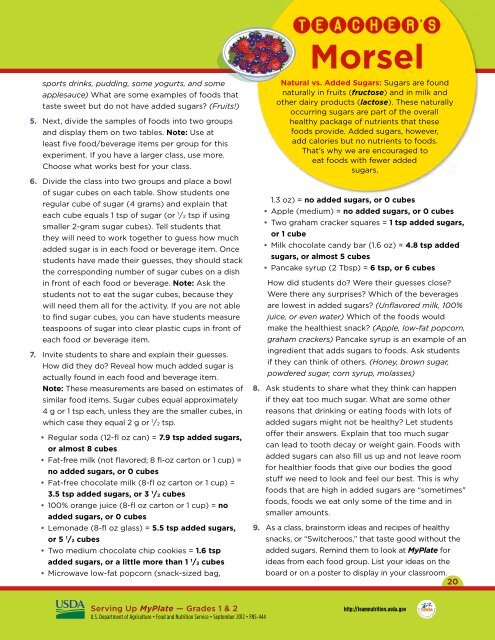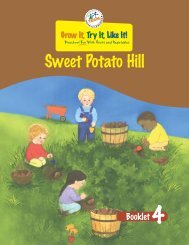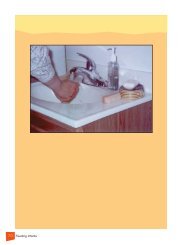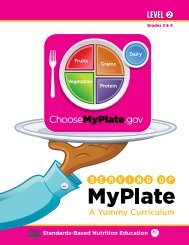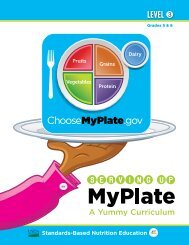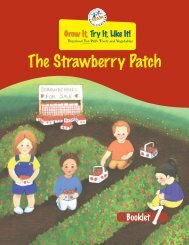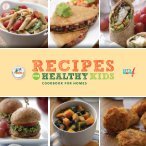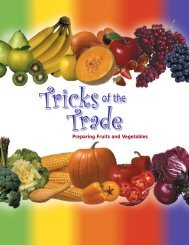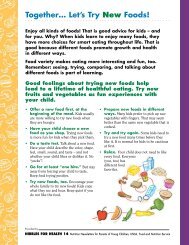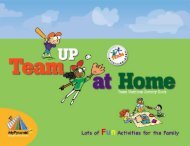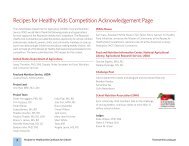Serving Up MyPlate-A Yummy Curriculum, Level 1 - Team Nutrition ...
Serving Up MyPlate-A Yummy Curriculum, Level 1 - Team Nutrition ...
Serving Up MyPlate-A Yummy Curriculum, Level 1 - Team Nutrition ...
Create successful ePaper yourself
Turn your PDF publications into a flip-book with our unique Google optimized e-Paper software.
sports drinks, pudding, some yogurts, and some<br />
applesauce) What are some examples of foods that<br />
taste sweet but do not have added sugars? (Fruits!)<br />
5. Next, divide the samples of foods into two groups<br />
and display them on two tables. Note: Use at<br />
least five food/beverage items per group for this<br />
experiment. If you have a larger class, use more.<br />
Choose what works best for your class.<br />
6. Divide the class into two groups and place a bowl<br />
of sugar cubes on each table. Show students one<br />
regular cube of sugar (4 grams) and explain that<br />
each cube equals 1 tsp of sugar (or 1 /2 tsp if using<br />
smaller 2-gram sugar cubes). Tell students that<br />
they will need to work together to guess how much<br />
added sugar is in each food or beverage item. Once<br />
students have made their guesses, they should stack<br />
the corresponding number of sugar cubes on a dish<br />
in front of each food or beverage. Note: Ask the<br />
students not to eat the sugar cubes, because they<br />
will need them all for the activity. If you are not able<br />
to find sugar cubes, you can have students measure<br />
teaspoons of sugar into clear plastic cups in front of<br />
each food or beverage item.<br />
7. Invite students to share and explain their guesses.<br />
How did they do? Reveal how much added sugar is<br />
actually found in each food and beverage item.<br />
Note: These measurements are based on estimates of<br />
similar food items. Sugar cubes equal approximately<br />
4 g or 1 tsp each, unless they are the smaller cubes, in<br />
which case they equal 2 g or 1 /2 tsp.<br />
• Regular soda (12-fl oz can) = 7.9 tsp added sugars,<br />
or almost 8 cubes<br />
• Fat-free milk (not flavored; 8 fl-oz carton or 1 cup) =<br />
no added sugars, or 0 cubes<br />
• Fat-free chocolate milk (8-fl oz carton or 1 cup) =<br />
3.5 tsp added sugars, or 3 1 /2 cubes<br />
• 100% orange juice (8-fl oz carton or 1 cup) = no<br />
added sugars, or 0 cubes<br />
• Lemonade (8-fl oz glass) = 5.5 tsp added sugars,<br />
or 5 1 /2 cubes<br />
• Two medium chocolate chip cookies = 1.6 tsp<br />
added sugars, or a little more than 1 1 /2 cubes<br />
• Microwave low-fat popcorn (snack-sized bag,<br />
TEACHER’S<br />
Morsel<br />
Natural vs. Added Sugars: Sugars are found<br />
naturally in fruits (fructose) and in milk and<br />
other dairy products (lactose). These naturally<br />
occurring sugars are part of the overall<br />
healthy package of nutrients that these<br />
foods provide. Added sugars, however,<br />
add calories but no nutrients to foods.<br />
That’s why we are encouraged to<br />
eat foods with fewer added<br />
sugars.<br />
1.3 oz) = no added sugars, or 0 cubes<br />
• Apple (medium) = no added sugars, or 0 cubes<br />
• Two graham cracker squares = 1 tsp added sugars,<br />
or 1 cube<br />
• Milk chocolate candy bar (1.6 oz) = 4.8 tsp added<br />
sugars, or almost 5 cubes<br />
• Pancake syrup (2 Tbsp) = 6 tsp, or 6 cubes<br />
How did students do? Were their guesses close?<br />
Were there any surprises? Which of the beverages<br />
are lowest in added sugars? (Unflavored milk, 100%<br />
juice, or even water) Which of the foods would<br />
make the healthiest snack? (Apple, low-fat popcorn,<br />
graham crackers) Pancake syrup is an example of an<br />
ingredient that adds sugars to foods. Ask students<br />
if they can think of others. (Honey, brown sugar,<br />
powdered sugar, corn syrup, molasses)<br />
8. Ask students to share what they think can happen<br />
if they eat too much sugar. What are some other<br />
reasons that drinking or eating foods with lots of<br />
added sugars might not be healthy? Let students<br />
offer their answers. Explain that too much sugar<br />
can lead to tooth decay or weight gain. Foods with<br />
added sugars can also fill us up and not leave room<br />
for healthier foods that give our bodies the good<br />
stuff we need to look and feel our best. This is why<br />
foods that are high in added sugars are “sometimes"<br />
foods, foods we eat only some of the time and in<br />
smaller amounts.<br />
9. As a class, brainstorm ideas and recipes of healthy<br />
snacks, or “Switcheroos,” that taste good without the<br />
added sugars. Remind them to look at <strong>MyPlate</strong> for<br />
ideas from each food group. List your ideas on the<br />
board or on a poster to display in your classroom.<br />
20<br />
<strong>Serving</strong> <strong>Up</strong> <strong>MyPlate</strong> — Grades 1 & 2 http://teamnutrition.usda.gov<br />
U.S. Department of Agriculture • Food and <strong>Nutrition</strong> Service • September 2012 • FNS-444


